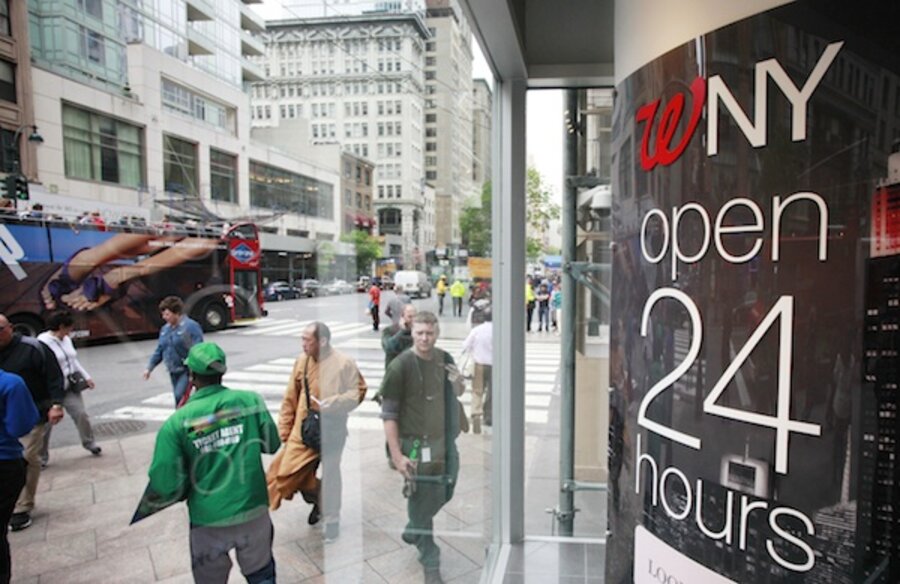Wall Street: turbulent quarter. Main Street: sleepy growth.
Loading...
The last trading day of the second quarter ended with stocks falling and gold rallying, one last hurrah for a volatile three months that saw investor sentiment sway dramatically and gold notch its biggest decline in at least 45 years.
For all the drama on Wall Street, however, the economy itself keeps sending signals of growth that's sluggish, even boring, but also steady. This week's economic reports fit into that picture of modest growth.
Once the haven for investors seeking safety from uncertain markets, gold has accelerated its long descent. From its 2011 high, the the glittery metal has lost about a third of its value, with more than half of that loss coming in the past three months. On Friday, gold rallied nearly 2 percent to close at $1,232.30 an ounce in New York, still far below its $1,900 high set in 2011. By contrast, the Dow Jones Industrial Average fell 114 points, or 0.76 percent, to close below the 15000 mark.
Much of the volatility has come in the wake of Federal Reserve statements suggesting that the US central bank would being to pare back its purchase of
Treasury securities, which have kept interest rates so low. Since May, bond rates have surged and prices (which move in the inverse direction) have tumbled. Mortgage rates, too, have surged about half a percentage point.
But none of these developments have stopped the broader economy's positive trajectory. This week's economic reports delivered upbeat signals:
Consumers are feeling good: Americans continue to feel better and better about the direction of the economy. The Conference Board’s index of US consumer confidence rose to 81.4 in June, a post-recession high and well above the consensus prediction of 75. According to the index, consumers were increasingly hopeful about the labor market, and the proportion of respondents planning to buy a home or a car within the next six months ticked higher.
In a separate gauge, consumer sentiment improved as well, according to the Thomson Reuters/University of Michigan's final reading for the month. The index stood at 84.1, near the six-year high set in May. “These data have been volatile of late, but are in a solid uptrend,” MFR Inc. economist Josh Shapiro wrote via e-mailed analysis. Nonetheless, absolute levels of consumer confidence and sentiment indices are still quite weak on a historical basis even with the significant post-recession gains.
Housing recovery is humming along: The run of good housing news continued this week, with home prices, sales, and pending home sales all rising. The S&P/Case-Shiller 20-city home price index rose 1.72 percent in April and increased 12.05 percent from a year ago. Prices in all 20 cities in the index rose for the fifth consecutive month. “Low inventories and gradually improving housing demand have combined to push housing starts higher and support home price appreciation,” Barclays Research economist Michael Gapen wrote in an e-mailed analysis. “Higher mortgage interest rates, however, could dampen some of the price momentum in the coming months if the back-up in mortgage rates in the past two months remains.”
Meanwhile, new home sales reached their highest level since 2008, increasing 2.1 percent in May to a 476,000 annualized rate. New sales rose in every region but the South. “One should never get too giddy or too glum by the latest new home sales figures,” IHS economist Patrick Newport wrote via e-mailed analysis. “With that caveat, we consider this report solid.”
Finally, pending existing home sales jumped 6.7 percent in May to their highest level in six years, suggesting another rise in actual existing home sales is coming for June, despite the move up in mortgage rates.
Personal income and spending are up: Personal income surged at a 0.5 percent rate in May. Wages and salaries increased by 0.3 percent, and the savings rate held steady at 3.2 percent. Spending gains increased by 0.3 percent, bouncing back from a 0.3 percent drop in April. “This is a relatively good report,” Chris Christopher, IHS director of consumer economics, wrote. “Recent news on the consumer front has been favorable. Consumer confidence is gaining ground, pump prices are “relatively” low, and housing is looking brighter. Looking ahead, we expect real consumer spending to increase around 2.0% for the entire year."
Jobless claims are down: The number of people applying for unemployment benefits for the first time fell last week, dropping by 9,000 to a seasonally adjusted 346,000 claims.








